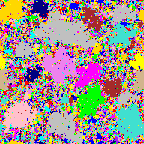
SPONTANEOUS SELF ORGANIZATION & EMERGENT ORDER:
A common analogue used to describe feedback systems is that of a
Boolean network, which consists of a number of elements or cells. Each
cell is connected to others and receives inputs from
some or all of the others, and also sends to some or all of the others.The
state of an individual cell changes from moment to moment according to the
rules it follows for converting these to activation
or output.
An example of a Boolean network has commonly been portrayed as a network
of colored light bulbs, each of which can be switched on or off. Each bulb
is also assigned a rule which tells it whether it should be turned on or
off. For example one particular bulb may follow the rule that it will switch
on if all other bulbs to which it is connected are switched on. Or perhaps
that a particular bulb will turn on as soon as two of these bulbs to which
it is connected to, are switched on. Thus,
the bulb's response is determined by the inputs it receives, according to
a fixed "decision-making"
rule.

The important point to gain from the Boolean network example is that 'random
level rules of behaviour' can result in emergent order at a global level,
and whether or not there is order depends upon the degree of connectedness
between elements of the network.Therefore, Boolean networks have shown that
these systems display simple stable behaviour when connectivity (interdependence)
is sparse and random patterns when connectivity is very strong.
Just before such systems go completely random (i.e. at the edge of chaos)
another form of behaviour exists. It is one in which coherent structures
grow, split apart, and recombine in a never ending way. It is at this position
at the edge of chaos , where emergent order and incredible diversity
reign, that the 'game' of evolution is beleived to be played.
Complexity as seen in evolution
Complexity index

